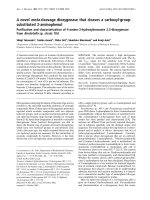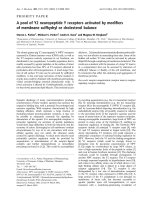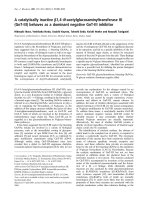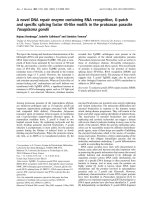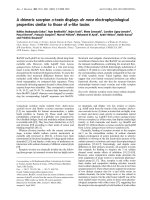Báo cáo y học: " A duplex real-time reverse transcriptase polymerase chain reaction assay for detecting western equine and eastern equine encephalitis viruses?" docx
Bạn đang xem bản rút gọn của tài liệu. Xem và tải ngay bản đầy đủ của tài liệu tại đây (427.79 KB, 5 trang )
SHORT REPOR T Open Access
A duplex real-time reverse transcriptase
polymerase chain reaction assay for detecting
western equine and eastern equine
encephalitis viruses
Xiaoping Kang, Yuchang Li, Hong Liu, Fang Lin, Xuyu Cai, Tingting Sun, Guohui Chang, Qingyu Zhu, Yinhui Yang
*
Abstract
In order to establish an accurate, ready-to-use assay for simultaneous detection of Eastern equine encephalitis virus
(EEEV) and Western equine encephalitis virus (WEEV), we developed one duplex TaqMan real-time reverse transcrip-
tase polymerase chain reaction (RT-PCR) assay, which can be used in human and vector surveillance. First, we
selected the primers and FAM-labeled TaqMan-probe specific for WEEV from the consensus sequence of NSP3 and
the primers and HEX-labeled TaqMan-probe speci fic for EEEV from the consensus sequence of E3, respectively.
Then we constructed and optimized the duplex real-time RT-PCR assay by adjusting the concentrations of primers
and probes. Using a series of dilutions of transcripts containing target genes as template, we showed that the sen-
sitivity of the assay reached 1 copy/reaction for EEEV and WEEV, and the performance was linear within the range
of at least 10
6
transcript copies. Moreover, we evaluated the specificity of the duplex system using other encephali-
tis virus RNA as template, and found no cross-reactivity. Compared with virus isolation, the gold standard, the
duplex real time RT-PCR assay we developed was 10-fold more sensitive for both WEEV and EEEV detection.
Introduction
Eastern equine encephalitis virus (EEEV) and western
equine encephalitis vir us (WEEV) are both arthropod-
borne viruses, belonging to the genus Alphavirus, family
Togaviridae. Both viruses are mainly spread in America
and transmitted by mosquitoes to equines, birds and
humans, causing a febrile disease (including encephali-
tis) with a significant frequency of fatal outcomes. The
fatality rate of EEEV is approximately 30-70% [1,2], the
most severe one among the arboviral encephalitis; while
the fatality rate of WEEV is approximately 3%. Although
there is an obvious difference in case fatality rate
between the two species, they share a high similarity in
genome sequence and antigenicity. In order for better
rescue and precaution procedures for WEEV and EEEV
infection, it is crucial to develop rapid and accurate
methods to detect and discriminate these two species.
Compared with traditional methods such as RT-PCR,
IFA, ELISA and virus isolation, real-time RT-PCR has
the advantage of fast speed and improved sensitivity.
Therefore, it has been developed quickly and become
the main method for pathogen detection[3]. Real-time
RT-PCR has the ability to measure several fluorophores
in one well and permits multiplex assays, so it can be
used to detect different target sequences simultaneously
in one reaction [4].
In this study, we designed the primers and probes of
real-time RT-PCR for EEEV and WEEV, and we have
established a duplex real time RT-PCR method for
simultaneously detection and discrimination of these
two viruses.
Materials and methods
Primer and probe design
The primers and probes for EEEV and WEEV detection
were designed by software SDS2.0, which were list in
table 1. The target sequences were selected from the
conserved regions of E3 gene for WEEV and NSP3 gene
* Correspondence:
State Key Laboratory of Pathogen and Biosecurity, Beijing Institute of
Microbiology and Epidemiology, Beijing 100071, China
Kang et al . Virology Journal 2010, 7:284
/>© 2010 Kang et al; licensee BioMed Central Ltd. This i s an Open Access article distributed under the terms of the Creative Commons
Attribution License ( which permits unres tricted use, distribution, and reproduction in
any medium, provided the original work is properl y cited.
for EEEV, respectively. T he specificity of the primers
and probes was confirmed b y BLAST in Genbank, the
matched sequences in other species were less than 50%.
The probe for EEEV was labeled with the reporter HEX
at the 5′ endandTAMRAatthe3′ end, and the probe
for WEEV was labeled with the reporter FAM at the 5′
end and TAMRA at the 3′ end.
Virus culture and isolation
WEEV (McMillan stain) and EEEV (SSP. North American
variant) were cultured in BHK-21 cells, and the superna-
tants were collected after cytopathic effect (CPE) appeared.
Virus isolation was conducted by cell culture. BHK cells
were inoculated with different dilutions (a series of dilu-
tion of 1-10
10
) of WEEV and EEEV and incubated at 37°C,
and CPE was observed after 4 days. All virus isolations
were performed in quadruplicate. The titres of WEEV and
EEEV were determined by tissue culture infective dose per
ml (TCID
50
/ml). The titre was 2 × 10
8
TCID
50
/ml for
EEEV and 5 × 10
8
TCID
50
/ml for WEEV, respectively.
Reference strains in this study included Chikgunya virus
(CHIK), Japanese B encephalitis virus (JEV), Tick born
encephalitis virus ( TBEV), St. L ouis encephaliti s virus
(SLEV), Dengue virus (DEN) and Yellow fever virus (YFV).
Nucleic acid extraction
RNA was extracted from the supernatants of cultured
viruses by RNeasy mini kit (Qiagen Inc., Valencia, CA,
USA) according to the manufacture’s instructions. All
the RNA extraction procedure was conducted at BSL-3
laboratory.
In vitro transcription of plasmid DNA
Using linearised plasmid DNA containing the target
sequence, RNA was transcribed in vitro with the Ribop-
robe(r) System-SP6/T7 (Promega, USA) according to the
manufacturer’s instructions. The T7-transcribed posi tive
control was digested with DNase and purified with the
RNeasy Kit (Qiagen, USA). The correct size of the
transcribed RNA was confirmed by formaldehyde agarose
gel electrophoresis, and the concentration was deter-
mined by spectroph otometry. The stock solutions of the
in vitro-transcribed RNA were stored at -70°C, and the
diluted working solutions were stored at -20°C [5].
Sensitivity and specificity of the duplex real-time RT-PCR
assay
The sensitivity of the duplex real-time RT-PCR
was conducted as follows: the reaction consisted of 10 μL
2 × reaction buffer, 0.2 μL reverse transcription enzyme,
250 nmol/L primers for WEEV and 500 nmol/L for
EEEV, 150 nmol/L probes for WEEV and 250 nmol/L for
EEEV. In the analysis, 2 uL serial diluted transcript RNA
of EEEV or WEEV (0.01-10
6
copies, 10-fold diluted) was
added into the tubes as template, deionized water were
added to the final volume of 20 uL. PCR was performed
with a LightCycler 2.0 (Roche, Switzerland). The reac-
tions were incubated at 50°C for 30 min, followed by
95°C for 10 min (inactivation reverse transcriptase/activa-
tion Taq polymerase), 45 cycles of 95°C for 15 s (dena-
turation), and 55°C for 1 min (annealing). The
fluorescence emitted from the assay was captured during
the annealing phase of each cycle at 530 nm for WEEV
and 560 nm for EEEV, respectively. The results were ana-
lyzed with LightCycler software (version 4.05). The RNAs
of reference strains were also tested with this assay in
order to examine the assay specificity [6-8].
Detection of the mimic samples by the duplex real-time
RT-PCR
The mimic samples were prepared by mixing the virus
with the mouse brain tissue, then the brain tissues were
grinded, and the RNA was extracted and applied with
the duplex real-time RT-PCR assay.
Results
Sensitivity and specificity analysis of the duplex system
Figure 1 and Table 2 show the sensitivity of the duplex
system: the detection limit reached 1 copy/reaction for
both EEEV and WEEV. Moreover, the performance
was linear for at least 10
6
transcript copies. The posi-
tive signals only appeared in one default channel, 530
nm for WEEV and 560 nm for EEEV, indicating no
cross reaction between the two species in the duplex
system.
To evaluate the cross-reaction with other encephalitis
viruses, a panel of six viruses including JEV, TBEV, CHIK,
DEN, YFV and SLEV were tested. All the samples
appeared to be negative and only background fluorescence
levels were observed (data not shown), demonstrating that
our real-time RT-PCR detection system was specific for
EEEV and WEEV.
Table 1 Primer and probe sequences for the duplex real-
time RT-PCR for EEEV and WEEV
Name of
primer or
probe
Sequence (5’®3’) Nucleotide
start
EEE-F TGTGCGTACCTCCTCATCGTT 335
EEE-R GACTGGCGTGAATCTCTGCTT 414
EEE-Probe HEX-
AGCAGCCTACCTTTCCGACAATGGTTGTC-
TAMRA
364
WEE-F AGGGATACCCCCGAAGGTT 8220
WEE-R GTGAATAGCACACGGGTGGTT 8322
WEE- Probe CTTTCGAATGTCACGTTCCCATGCG 8274
Kang et al . Virology Journal 2010, 7:284
/>Page 2 of 5
Figure 1 Analytical sensitivity of the duplex real time RT-PCR assay based on the 10-fold dilution series of the in vitro-transcribed
RNA. The amplification blot for EEEV(A) and the associated standard curve graph (B)for EEEV, The amplification blot for WEEV(A) and the
associated standard curve graph (D)for WEEV, are all depicted.
Kang et al . Virology Journal 2010, 7:284
/>Page 3 of 5
Sensitivity of the duplex system compared to virus
isolation
For a comparative study of the duplex real-time RT-
PCR system and the virus isolation, a serial of 10-fold
diluted culture supernatants of WEEV and EEEV were
prepared. One aliquot of each dilution was used for
virus isolation, and a second aliquot was used for RNA
extraction and duplex real-time RT-PCR analysis. Table
2 demonstrates that the duplex real-time RT-PCR assay
was 10-fold more sensitive than virus isolation for both
WEEV and EEEV detection.
Detection of the mimic samples
The mimic samples were prepared by mixing the virus
with the mouse brain tissue, and then used for real-time
RT-PCR detection. The positive results for EEEV or
WEEV was obtained. The assay was also tested with the
virus mixture containing both EEEV and WEEV, and
the positive signals were appeared both at 530 nm and
560 nm, indicating that this duplex system is suitable
for detecting both EEEV and WEEV infection.
Discussion
Antibodies against EEEV has been f ound in the serum of
some encephalitis patients in China by using immuno-
fluorescence assay [9,10], but no EEEV and WEEV strains
have been isolated so far. Due to the cross-reaction
among Alphavirus by immunoassay, it remains unclear
whether EEEV infection exits in China. With the globa li-
zation of international trade, t he rapid and free move-
ment of large amounts of peop le, animals, food and feed
products has created the risk of a novel and epidemi olo-
gically vulnerable situation. Infectious agents have a
chance to sprea d all over the world within several hours
or days. In order to better control import infection and
monitor the prevalence of encephalitis diseases in China,
it is urgent to develop rapid and accurate methods for
WEEV and EEEV detection.
There are several widely used methods for arboviral
pathogen detection including indirect hemagglutination
inhibition (IHI), ELISA, virus isolation and RT-PCR.
However, each method has its own disadvantages: serolo-
gic tests have the limit of cross-reaction [11], and virus
isolation is time-consuming and requires biosafety level-3
containment. Reverse-transcriptase PCR (RT-PCR) is a
rapid and sensitive m ethod that is being increasingly
used as an adjunct to serology for arbovirus diagnosis
[11,3]. Real-time RT-PCR is more sensitive a nd specific,
so it is a preferred method for pathogen detection.
Some assays for WEEV and EEEV diagnostics have
been developed. Hull et al. developed a duplex real-time
RT-PCR assay for EEEV and St. Louis virus [12]; Carrera
et al. developed a multiple RT-PCR for 13 arboviruses
[5]. Eshoo de veloped an RT-PCR assay for alphavirus
detection[13]. Pässler et al. developed a detecting assay
for alphaviruses based on antibodies [14]. Lambert et al.
developed an RT-PCR assay and Taqman RT-PCR assay
for WEEV and EEEV [11]. But none o f the above meth-
ods was available for detecti ng and distinguishing WEEV
and EEEV in a single reaction.
In this study, we developed and validated a duplex real-
time RT-PCR system for both WEEV and EEEV detection
at the same time. The primers and probes were selected
from E3 gene for WEEV and NSP3 gene for EEEV, and
the sequence analysis confirmed the specificity for WEEV
and EEEV, respectively. Using other encephalitis viruses
RNA(e.g.,DEN,CHIK,TBEandJEV)astemplate,no
cross-reaction signals were detected, demonstrating the
specificity of the duplex system.
Using the same concentrations of the primers and
probes for EEEV and WEEV, the sensitivity of the duplex
real-time RT-PCR system was similar for WEEV and was
20-fold lower for EEEV compared with the single system.
In order to improve the sensitivity of the duplex system,
we further optimized the concentrations of the primers
and probes for EEEV. First, the assay was conducted with
different primer concentrations (125, 250, 375, 500, 625
and 750 nmol/L), and the template was a serial of diluted
EEEV RNA transcripts. Second, the optimal probe concen-
trations were determined with different probe concentra-
tions (100, 150, 200, 250 and 300 nmol/L). The most
proper primer/probe concentration was achieved by
reaching the lowest Ct at the fixed amount of template.
Our results showed that the optimal EEEV primer con-
centration was 500 nmol/L each and the optimal EEEV
Table 2 Sensitivity of the real-time RT-PCR assay and
virus isolation
Virus Dilution Virus isolation Real time RT-PCR CT
WEEV 10
-1
4/4 + 15.25
10
-2
4/4 + 18.29
10
-3
4/4 + 22.02
10
-4
4/4 + 25.49
10
-5
4/4 + 29.28
10
-6
2/4 + 32.79
10
-7
0/4 + 36.03
10
-8
0/4 -
TCID
50
:10
6
/0.1 ml
EEEV 10
-1
4/4 + 11.37
10
-2
4/4 + 16.25
10
-3
4/4 + 18.54
10
-4
4/4 + 22.03
10
-5
4/4 + 27.35
10
-6
2/4 + 30.18
10
-7
1/4 + 34.79
10
-8
0/4 + 37.59
TCID
50
:10
6.25
/0.1 ml
Kang et al . Virology Journal 2010, 7:284
/>Page 4 of 5
probe concentration was 250 nmol/L; the optimal WEEV
primer concentration was 250 nmol/L each and the opti-
mal WEEV probe concentration was 150 nmol/L. With
these optimized parameters, the assay finally reached
1copy/reation for both WEEV and EEEV.
Furthermore, we compared the duplex RT-PCR system
with virus isolatio n, the ‘gold standard’ in v irus diagnos -
tics. The results showed that our duplex real-time RT-
PCR was more sensitive than cell culture isolation. Taken
together, the duplex real-time RT-PCR system we devel-
oped is a robust and valuable tool for highly sensitive and
specific detection of WEEV and EEEV infection.
Acknowledgements
This study was supported by National Key Research Special Foundation of
China (Grant no. 2008ZX10004-001 & 2009ZX10004-103).
Authors’ contributions
XK: designed the study, did laboratory testing, analysed the test results, co-
wrote and edited the manuscript. YL, H L, FL, XC, TS and GC took samples
and did laboratory testing. QZ and YY organized the overall project and
helped edit the manuscript. All the authors read and approve the final
manuscript.
Competing interests
The authors declare that they have no competing interests.
Received: 23 July 2010 Accepted: 26 October 2010
Published: 26 October 2010
References
1. Brault AC, Powers AM, Chavez CLV, Lopez RN, Cachon MF, Gutierrez LFL,
Kang W, Tesh RB, Shope RE, Weaver SC: Genetic and antigenic diversity
among eastern equine encephalitis viruses from North, Central and
South America. Am J Trop Med Hyg 1999, 61:579-586.
2. Deresiewicz RL, Thaler SJ, Hsu L, Zamani AA: Clinical and
neuroradiographic manifestations of eastern equine encephalitis. N Engl
JMed1997, 336:1867-1874.
3. Linssen B, Kinney RM, Aguilar P, Russell KL, Watts DM, Kaaden OR, Pfeffer M:
Development of reverse transcription-PCR assays specific for detection
of equine encephalitis viruses. J Clin Microbiol 2000, 38:1527-1535.
4. Xiao-Ping KANG, Yong-Qiang LI, Sun Qing-Ge, Hong LIU, Yin-Hui YANG,
Qing-Yu ZHU: Development of a consensus microarray method for
identification of some severe infective viruses. Journal of Medical Virology
2009, 81:1945-1950.
5. Carrera M, Sagripanti JL: Non-infectious plasmid engineered to simulate
multiple viral threat agents. J Virol Methods 2009, 159:29-33.
6. Lambert AJ, Martin DA, Lanciotti RS: A universal heterologous internal
control system for duplex real-time RT-PCR assays used in a detection
system for pestiviruses B. In Journal of Virological Methods Edited by:
Hoffmann K, Depner H, Schirrmeier, Beer M 2009, 136:200-209.
7. Hoffmann B, Beer M, Schelp C, Schirrmeier H, Depner KM: Validation of a
real-time RT-PCR assay for sensitive and specific detection of classical
swine fever. Journal of Virological Methods 2005, 130:36-44.
8. Xiaoping Kang, Tao Jiang, Yongqiang Li, Fang Lin, Hong Liu, Guohui Chang,
Qingyu Zhu, Chengfeng Qin, Yinhui Yang: A duplex real-time RT-PCR
assay for detecting avian influenza virus H5N1 and novel influenza virus
H1N1. Virology Journal 2010, 7:114.
9. Li Chen, Guodong Liang, Boquan Chen, Qiping Li, Ying He, Liting Song,
Zijiang Zhao, Yijun Huang: Detection of antibodies against Sindbis virus
and eastern equine encephalitis virus from human serum in China.
Chinese Journal of Experimental and Clinical Virology 1994, 8(4):371-371, (In
Chinese).
10. Qiping Li, Guodong Liang, Jichu Xie: Isolation of primarily identification of
eastern equine encephalitis virus. Chinese Journal of Experimental and
Clinical Virology 1992, 6(1):58-59, (In Chinese).
11. Lambert AJ, Martin DA, Lanciotti RS: Detection of North American Eastern
and Western equine encephalitis viruses by nucleic acid amplification
assays. J Clin Microbiol 2003, 41:379-385.
12. Hull R, Nattanmai S, Kramer LD, Bernard KA, Tavakoli NP: A duplex real-
time reverse transcriptase polymerase chain reaction assay for the
detection of St. Louis encephalitis and eastern equine encephalitis
viruses. Diagn Microbiol Infect Dis 2008, 62:272-9.
13. Eshoo MW, Whitehouse CA, Zoll ST, Massire C, Pennella TT, Blyn LB,
Sampath R: Direct broad-range detection of alphaviruses in mosquito
extracts. Virology 2007, 368
:286-95.
14. Pässler S, Pfeffer M: Detection of North American eastern and western
equine encephalitis viruses by nucleic acid amplification assays. J Clin
Microbiol 2003, 41:379-85.
doi:10.1186/1743-422X-7-284
Cite this article as: Kang et al.: A duplex real-time reverse transcriptase
polymerase chain reaction assay for detecting western equine and
eastern equine encephalitis viruses. Virology Journal 2010 7:284.
Submit your next manuscript to BioMed Central
and take full advantage of:
• Convenient online submission
• Thorough peer review
• No space constraints or color figure charges
• Immediate publication on acceptance
• Inclusion in PubMed, CAS, Scopus and Google Scholar
• Research which is freely available for redistribution
Submit your manuscript at
www.biomedcentral.com/submit
Kang et al . Virology Journal 2010, 7:284
/>Page 5 of 5
